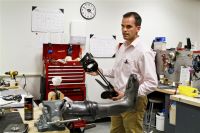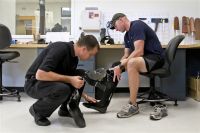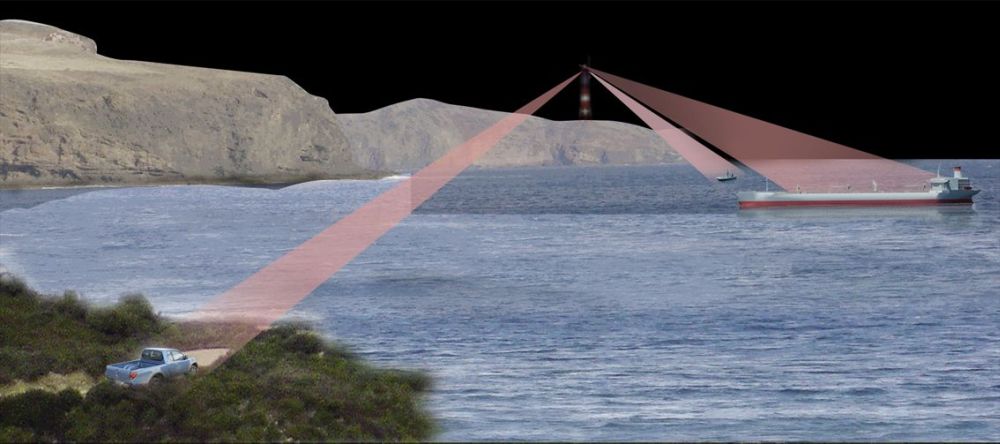SAN ANTONIO – A wounded warrior limped into Ryan Blanck’s office at the Center for the Intrepid here one day with a plea for help.
The doctors at Brooke Army Medical Center had saved the service member’s leg after a combat injury, but due to the pain, he couldn’t walk comfortably, let alone run.
Blanck, a leading prosthetic at the state-of-the-art rehab center, found himself in an unfamiliar position: at a loss. “There wasn’t a go-to option,” he said, referring to devices for wounded warriors with lower leg injuries.
So Blanck created one. He designed the Intrepid Dynamic Exoskeletal Orthosis, or IDEO, a streamlined, energy-storing brace that delivers nearly instantaneous results. Now, most troops with salvaged limbs who wheel or limp into his office walk out a short time later, pain and limp-free.
The injured warriors are impressed by the results. When they strap on the brace for the first time and start walking, Blanck said, some stumble midway across the room, but not due to discomfort.
“They’re uncontrollably weeping,” he said. “It’s the first time they’ve walked without pain in two or three, or seven years in one guy’s case.”
Brace Proves to be ‘Game-Changer’
Blanck’s creation is a lightweight, streamlined carbon-fiber device that can be tucked under a pant leg and into a boot or sneaker. It comprises a cuff that wraps around the leg just under the knee connected to a footplate by carbon-fiber rods.
The brace works by offloading the limb and allowing the patient to operate the lower limb in a way that avoids pain, he explained. When a service member’s heel strikes, the device stores energy through the gait cycle, then delivers it back to propel the foot forward.
“That’s the concept behind it all; energy storage and power,” he said.
Prior to IDEO, Blanck noted, “there wasn’t a combination device that would allow offloading, adequate range restriction and then power generation.”
The device is proving a “game-changer” for service members with salvaged limbs, said Johnny Owens, a CFI physical therapist who is working hand-in-hand with Blanck in treating IDEO-fitted warriors. “We’re seeing immediate changes we don’t usually see,” he said. Owens said the device also is singlehandedly helping to turn the tide on a trend of wounded warriors opting for delayed amputations — amputations several months after injury. He attributes the trend to the slow, and sometimes frustrating, recovery for troops with lower leg injuries.
“Prior to all this, limb salvage was a little bit of an unknown,” Blanck explained. “You couldn’t tell a patient, ‘you’re going to run.’”
But amputees — depending on the situation and barring other injuries — can regain significant functions about six months after amputation, he noted. Meanwhile, limb salvage patients sit on the sidelines watching their amputee battle buddies walking or running as their own progress proceeds painfully slow.
Frustrated by their limitations, some troops with salvaged limbs opted for late amputations.
“It’s enticing,” Owens said. “You’re in pain, but if you cut your leg off, you can run. Many invested a year or two in recovery and then decided to cut [a limb] off. It was psychologically frustrating to see these guys work so hard and then just cut it off.”
Thanks to IDEO, these troops now have another option, he said, that enables them to not only walk, but run, sprint and jump.
Returning to Service
Word is spreading of IDEO and its astounding results, and Blanck now is fitting troops from around the country with his device. After hearing of Blanck’s and Owens’ success, Army 1st Lt. Matthew Anderson traveled here from his unit at Fort Carson, Colo., hoping for similar results.
Anderson, an infantry platoon leader, was injured in October 2010 while on a dismounted combat patrol in Kandahar, Afghanistan. As his unit cleared a building, he stepped on a landmine. “It felt like a jackhammer hitting my ankle,” he recalled. The explosive shattered his heel into a dozen pieces.
The doctors salvaged his limb, but the injury left Anderson in pain and with a pronounced limp. While he was able to start walking again after about six months, this strapping, lifelong athlete figured his running days were over.
It took Blanck just a few minutes to prove him wrong. With the IDEO, Anderson was walking comfortably within minutes and running within days.
“It put the biggest smile on my face,” the infantry platoon leader said. He had stopped by the CFI early one morning so Blanck could make adjustments to his device and fit him for another.
“I went from walking with a severe gait issue and a limp to walking normally,” Anderson said.
Blanck finished his adjustments, and Anderson pulled a sneaker over the foot plate and walked across the office with a smooth stride.
Once he got the brace, “I could run on it, jump vertically, laterally shuffle,” Anderson said. “Things that there’s no way I’d be doing with that much speed, efficiency or lack of pain.
“For a guy that’s in his late 20s that’s always been a jock athlete, being hampered by these injuries is pretty tough mentally,” he continued. “When you’re given the option to get back into it, it’s huge; it means a lot to me.”
Anderson soon will return to duty at Fort Carson. Of the nearly 200 cases they’ve seen, Owens noted, more than 30 have returned to service and 11 have combat deployed.
As they test and improve the current design, Blanck and Owens also are looking into what they call a “widespread potential” for people with issues such as ankle arthritis, strokes and head, back and other injuries.
The program’s success has one limitation: space. Between amputees and warriors with salvaged limbs, the CFI can get crowded at times. The pair would like to see a rehab center like the CFI, but devoted to wounded warriors with salvaged limbs. There would be no shortage of demand, Owens said, noting that for every one amputee, there are about 10 limb salvage patients.
Meanwhile, they have no plans to cut back, no matter how great the demand. Just seeing the joy in a wounded warrior’s face at walking again pain-free, they said, makes every extra hour at work worthwhile.
“I never thought I’d come to work and get hugged by a 220-pound, 6‑foot‑4, Special Forces guy,” said Blanck with a smile, “but I’ve had a few hugs.
“I loved my job before this, but this is a whole new level.”
Source:
U.S. Department of Defense
Office of the Assistant Secretary of Defense (Public Affairs)

 von
von 



